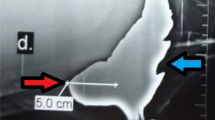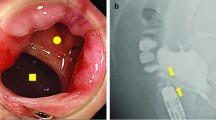Abstract.
A 35 years old woman developed obstructed defecation due to a large (6 cm) non-emptying rectocele one year after successful electrostimulated gracilis neosphincter operation for correction of fecal incontinence after surgery for imperforate anus. Surgical correction of the rectocele was performed by a trans-vaginal approach due to the poor elasticity of the neoanus and avoidance of possible damage to the neosphincter. After physiological investigations, including defecography, the patient had a resection of the posterior vaginal mucosal wall, a double layer plication of the muscular wall with non-absorbable suture and a longitudinal mucosal suture. The postoperative course was uneventful. Defecography, performed 3 and 6 months later, showed a marked reduction of the rectocele (2 cm) which corresponded to clinical improvement. Occurrence of disabling rectocele can be considered a possible long term complication after successful electrostimulated neosphincter procedure in patients at risk for developing a rectocele; a successful repair can be obtained using trans-vaginal approach without the risk of neosphincter damage. Transvaginal repair of rectocele in similar clinical situations may be recommended.
Résumé.
Une femme de 35 ans a développé une dyschésie en raison d'une rectocèle large de 6 cm, laquelle ne s'évacue pas, une année après la construction d'un néo-sphincter avec un muscle gracilis électrostimulé réalisée pour la correction d'une incontinence fécale après chirurgie d'une imperforation anale. La correction de la rectocèle a été réalisée par un abord transvaginal en raison de la mauvaise élasticité du néo-anus et afin d'éviter tout dommage au néo-sphincter. Après des investigations physiologiques comportant une défécographie, la patiente a subi l'excision de la muqueuse de la paroi postérieure du vagin, une double plicature de la paroi musculaire avec du matériel de suture non résorbable et une suture muqueuse longitudinale. L'évolution postopératoire est sans particularités. Une échographie réalisée à 3 et à 6 mois a permis de démontrer une réduction marquée de la taille de la rectocèle (2 cm) qui correspond à l'amélioration clinique observée. Une rectocèle invalidante peut être considérée comme une complication possible à long terme d'une reconstruction du néo-sphincter avec un muscle gracilis électrostimulé. Une réparation peut être envisagée avec succès par un abord transvaginal sans compromettre la fonction du néo-sphincter. Une réparation transvaginale des rectocèles dans des situations cliniques analogues peut être recommandée.
Similar content being viewed by others
Author information
Authors and Affiliations
Additional information
Accepted: 20 June 1996
Rights and permissions
About this article
Cite this article
Altomare, D., Rinaldi, M., Pannarale, O. et al. Vaginal repair of rectocele after dynamic graciloplasty for fecal incontinence due to imperforate anus. Int J Colorect Dis 11, 243–245 (1996). https://doi.org/10.1007/s003840050054
Issue Date:
DOI: https://doi.org/10.1007/s003840050054




